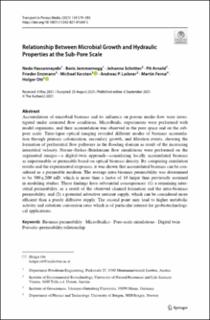| dc.contributor.author | Hassannayebi, Neda | |
| dc.contributor.author | Jammernegg, Boris | |
| dc.contributor.author | Schritter, Johanna | |
| dc.contributor.author | Arnold, Pit | |
| dc.contributor.author | Enzmann, Frieder | |
| dc.contributor.author | Kersten, Michael | |
| dc.contributor.author | Loibner, Andreas P. | |
| dc.contributor.author | Fernø, Martin | |
| dc.contributor.author | Ott, Holger | |
| dc.date.accessioned | 2022-04-08T09:20:58Z | |
| dc.date.available | 2022-04-08T09:20:58Z | |
| dc.date.created | 2021-12-15T18:30:07Z | |
| dc.date.issued | 2021 | |
| dc.identifier.issn | 0169-3913 | |
| dc.identifier.uri | https://hdl.handle.net/11250/2990724 | |
| dc.description.abstract | Accumulation of microbial biomass and its influence on porous media flow were investigated under saturated flow conditions. Microfluidic experiments were performed with model organisms, and their accumulation was observed in the pore space and on the sub-pore scale. Time-lapse optical imaging revealed different modes of biomass accumulation through primary colonization, secondary growth, and filtration events, showing the formation of preferential flow pathways in the flooding domain as result of the increasing interstitial velocity. Navier–Stokes–Brinkmann flow simulations were performed on the segmented images—a digital-twin approach—considering locally accumulated biomass as impermeable or permeable based on optical biomass density. By comparing simulation results and the experimental responses, it was shown that accumulated biomass can be considered as a permeable medium. The average intra-biomass permeability was determined to be 500 ± 200 mD, which is more than a factor of 10 larger than previously assumed in modeling studies. These findings have substantial consequences: (1) a remaining interstitial permeability, as a result of the observed channel formation and the intra-biomass permeability, and (2) a potential advective nutrient supply, which can be considered more efficient than a purely diffusive supply. The second point may lead to higher metabolic activity and substrate conversion rates which is of particular interest for geobiotechnological applications. | en_US |
| dc.language.iso | eng | en_US |
| dc.publisher | Springer | en_US |
| dc.rights | Navngivelse 4.0 Internasjonal | * |
| dc.rights.uri | http://creativecommons.org/licenses/by/4.0/deed.no | * |
| dc.title | Relationship Between Microbial Growth and Hydraulic Properties at the Sub-Pore Scale | en_US |
| dc.type | Journal article | en_US |
| dc.type | Peer reviewed | en_US |
| dc.description.version | publishedVersion | en_US |
| dc.rights.holder | Copyright 2021 The Author(s) | en_US |
| cristin.ispublished | true | |
| cristin.fulltext | original | |
| cristin.qualitycode | 2 | |
| dc.identifier.doi | 10.1007/s11242-021-01680-5 | |
| dc.identifier.cristin | 1969111 | |
| dc.source.journal | Transport in Porous Media | en_US |
| dc.source.pagenumber | 579-593 | en_US |
| dc.identifier.citation | Transport in Porous Media. 2021, 139 (3), 579-593. | en_US |
| dc.source.volume | 139 | en_US |
| dc.source.issue | 3 | en_US |

